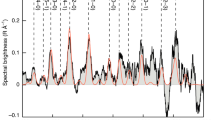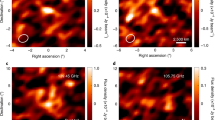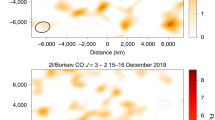Abstract
DISTANT comets are sometimes observed to undergo outbursts of activity that generate a surrounding coma, but the cause of this activity is not known1,2. Whereas such outbursts in near-Sun comets are driven by the sublimation of water ice3, distant comets are too cold for this process to operate. The most plausible mechanisms involve the release of trapped gases from ice heated by an exothermic phase transition from an amorphous to a crystalline state4–6, or the sublimation of very volatile ices such as molecular nitrogen and carbon monoxide7–9. Here we report the detection of emission from carbon monoxide at submillimetre wavelengths from a distant comet, the periodic comet Schwassmann–Wachmann 1. The inferred rate of CO production is sufficient to generate the observed coma. These results provide the first direct evidence that sublimation of volatiles can drive the activity of distant comets.
This is a preview of subscription content, access via your institution
Access options
Subscribe to this journal
Receive 51 print issues and online access
$199.00 per year
only $3.90 per issue
Buy this article
- Purchase on Springer Link
- Instant access to full article PDF
Prices may be subject to local taxes which are calculated during checkout
Similar content being viewed by others
References
Roemer, E. Publs astr. Soc. Pacif. 74, 351–365 (1962).
Sekanina, Z., Larson, S. M., Hainaut, O., Smette, A. & West, R. M. Astr. Astrophys. 263, 367–386 (1992).
Whipple, F. L. Astrophys. J. 111, 375–394 (1950).
Klinger, J. Science 209, 271–272 (1980).
Smoluchowski, R. Astrophys. J. 244, L31–L34 (1981).
Bar-Nun, A., Dror, J., Kochavi, E. & Laufer, D. Phys. Rev. B35, 2427–2435 (1987).
Cowan, J. J. & A'Hearn, M. F. Icarus 50, 53–62 (1982).
Fanale, F. P. & Salvail, J. R. Icarus 84, 403–413 (1990).
Crovisier, J. in Workshop on the Activity of Distant Comets (eds Huebner, W. F., Keller, H. U., Jewitt, D., Klinger, J. & West R.) 153–160 (Southwest Research Institute, San Antonio, 1992).
Whipple, F. H. Astr. J. 85, 305–313 (1980).
Hughes, D. W. in Comets in the Post-Halley Era (eds Newburn, R. L. Jr, Neugebauer, M. & Rahe, J.) 825–851 (Kluwer, Dordrecht, 1991).
Larson, S. M. Astrophys. J. 238, L47–L48 (1980).
Cochran, A. L. & Cochran, W. D. Icarus 90, 172–175 (1991).
Jewitt, D. Astrophys. J. 351, 277–286 (1990).
Senay, M. C. & Jewitt, D. IAU Circ. No. 5929 (1994).
Matthews, H. E. in The James Clerk Maxwell Telescope: A Guide for the Prospective User (ed. Matthews, H. E.) 1–25 (Joint Astronomy Center, Hilo, 1993).
Lellouch, E. et al. IAU Circ. No. 5994 (1994).
Matthews, H. E. JCMT Newsletter No. 2, 5–7 (Royal Observatory, Edinburgh, 1994).
Chin, G. & Weaver, H. A. Astrophys. J. 285, 858–869 (1984).
Bockelee-Morvan, D. & Crovisier, J. Astr. Astrophys. 151, 90–100 (1985).
Crovisier, J. & Le Bourlot, J. Astr. Astrophys. 123, 61–66 (1983).
Eberhardt, P. et al. Astr. Astrophys. 187, 481–484 (1994).
Jockers, K., Bonev, T., Ivanova, V. & Rauer, H. Astr. Astrophys. 260, 455–464 (1992).
Fulle, M. Nature 359, 42–44 (1992).
Sykes, M. V. & Walker, R. G. Icarus 95, 180–210 (1992).
Brown, G. N. & Ziegler, W. T. Adv. cryogen. Engng 25, 662–670 (1979).
Schmitt, B. in Interrelations Between Physics and Dynamics for Minor Bodies in the Solar System (eds Benest, D. & Froeschle, C.) 265–307 (Editions Frontieres, Gif-sur-Yvette, 1992).
Cruikshank, D. P. & Brown, R. H. Icarus 56, 377–380 (1983).
Meech, K. J., Belton, M. J. S., Mueller, B. E. A., Dicksion, M. W. & Li, H. R. Astr. J. 106, 1222–1236 (1993).
Jewitt, D. in Comets in the Post-Halley Era (eds Newburn, R. L. Jr, Neugebauer, M. & Rahe, J.) 19–65 (Kluwer, Dordrecht, 1991).
Sekanina, Z. Astr. J. 100, 1293–1314 (1990).
Keller, H. U. in Physics and Chemistry of Comets (ed. Huebner, W. F.) 13–68 (Springer, Berlin, 1990).
Author information
Authors and Affiliations
Rights and permissions
About this article
Cite this article
Senay, M., Jewitt, D. Coma formation driven by carbon monoxide release from comet Schwassmann–Wachmann 1. Nature 371, 229–231 (1994). https://doi.org/10.1038/371229a0
Received:
Accepted:
Issue Date:
DOI: https://doi.org/10.1038/371229a0
This article is cited by
-
Spitzer’s Solar System studies of comets, centaurs and Kuiper belt objects
Nature Astronomy (2020)
-
Neutral Atmospheres
Space Science Reviews (2008)
-
Putting the CO in coma
Nature (1999)
Comments
By submitting a comment you agree to abide by our Terms and Community Guidelines. If you find something abusive or that does not comply with our terms or guidelines please flag it as inappropriate.



